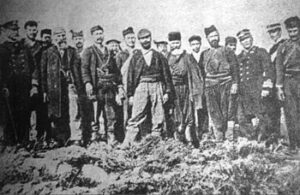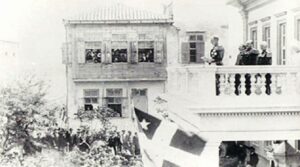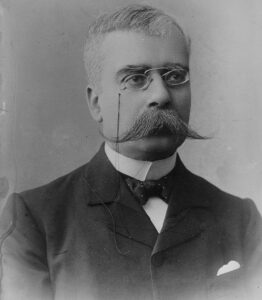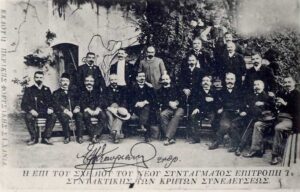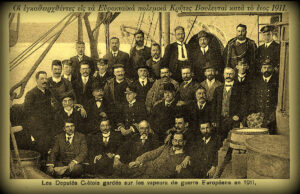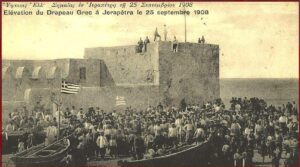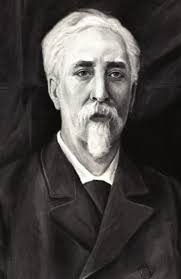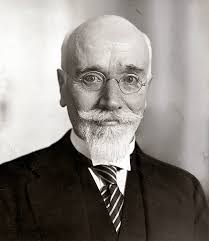The Cretan State and the Union with Greece
The Cretan State 1898 - 1913
Crete only became-art of Greecein 1913,even though numerous violent uprisings occurred throughout the 19th century. The reasons for this delay were threefold:
- The exceptional geostrategic position of Crete, which controls passage to and from the Aegean and the Black Sea towards the Mediterranean, with the port of Souda, which offers an exceptional harbour for large ships. The Ottoman Empire obviously did not wish to lose this fortified position.
- Crete was point of contention of the Great Powers of the time, which, for their own reasons, sought to retain the status quo established in 1815 at the Congress of Vienna.
- The risk of generalized unrest in Europe due to a regime change on Crete: Crete was the Achilles heel of the “sick man of Europe”. the consequences of a shift in the balance of power were unforeseeable, not only for Greco-Turkish relations, but also for relations between the Powers themselves and as well as with Greece and the Ottoman Empire.
Following the final Cretan revolt of 1897 and the unfortunate Greco-Turkish war that took place the same year, which ended in Greece’s defeat, the Great Powers, proposed to the Assembly of Cretan representatives that they accept autonomy under the suzerainty of the Porte with Prince George, the second son of the Greek king, acting as High Commissioner, and to abandon, at least provisionally, their goal of union with Greece. However, the massacre at Heraklion by Turkish Bashi-Bazouk irregulars brought on a rapid turn of events: The Ottomans departed from Crete at the end of 1898 and the Cretans surrendered their arms.
The arrival of Prince George on December 9, 1898 was considered an initial commitment towards union with Greece and marked the commencement of the Period of the Cretan State, which came to an official close on December 1st 1913, when the Greek flag was raised above the fortress of Firkas in Chania
The main achievement of this period was enacting the Constitution that set out the duties and rights of the sovereign, the composition and operation of Parlament, the judiciary, while also establishing and protecting certain rights. Even though it granted almost unlimited powers to Prince George, it was considered to constitute the basis for the protection of both Christians and Muslims, as well asa point of departure for the economic and social development of the island. In fact the government of autonomous Crete did succeed in the difficult task of the administrative, judicial and economic restructuring of the island.
After the Therisso revolt and the removal of George in 1906, the government of the Cretan State proclaimed the independence of Crete and its unification with Greece in 1908, while the second High Commissioner Alexandros Zaimis resigned in June 1909.
The final period, leading up to 1913, was marked by a quick succession of events and rapid reversals, but happily resulted in union with Greece, after the latter’s successes in the Balkan Wars of 1912 and 1913.
It should be noted that thirty governments were formed from 1899 to 1913, which though memoranda and demarcates, peaceful and/or with revolutionary means, attempted to sway the Great Powers and the faint-hearted stance of Greece and achieve Union. This course of events, driven by people and politicians of Crete, finally transformed an underrated backwater of the Ottoman Empire into a contemporary part of Greece.
The Revolution of 1897
The revolution broke out following the atrocities perpetrated by Muslims in Cretan towns. The Great Powers intervened, while Greek government sent an army to invade Crete. However, following the Unfortunate War”of 1897, Greece was forced to withdraw its forces from Crete and the Cretans accepted an autonomous regime.
1st period of the Cretan Sate, 1898-1905
During this period the first Cretan government was formed and laws were passed on how the courts would function, how to combat animal theft, how to protect antiquities, organise education, economic development, improving transport. Additionally the Cretan Gendarmerie was organised along the lines of the Italian carabinieri.
The Therisso revolt, 1905-1906
The high-handed manner of the High Commissioner’s rule, the delay in unification with Greece and the difference of options between Venizelos and Prince George caused the Therisso revolt. George was forced to depart Crete in 1906 and position was given to Greek politician Alexandros Zaimis by decision of King George.
2nd period of the Cretan State, 1906-1908
The two main achievements of this period were the enactment of the Constitution of 1907, which limited the powers of the Commissioner and reinforced the role of the Cretan Militia, which Greek officers undertook to train.
3rd period of the Cretan State, 1908-1912
In 1908 the union of Crete with Greece was proclaimed by decision of all the political powers of the island. However, the stagnant condition let to armed gatherings and to the formation of the Revolutionary Assembly in 1911, as well as to the initially unsuccessful attempts by Cretan elected members to participate in the Hellenic Parliament.
The road to the Union, 1912-1923
Shortly following the start of the 1st Balkan War, Stefanos Dragoumis was appointed Governor General of Crete by Prime Minister Eleftherios Venizelos. The final process of union with Greece commenced in February 1913 and it was completed with an official ceremony on December 1, 1913










